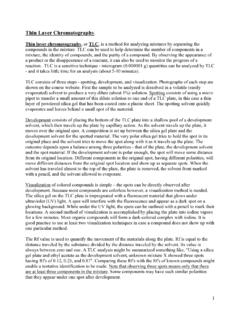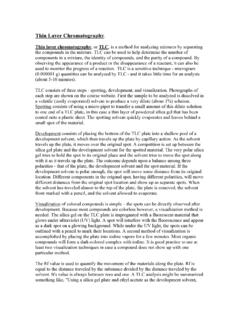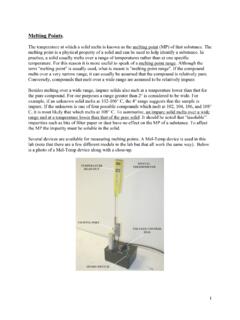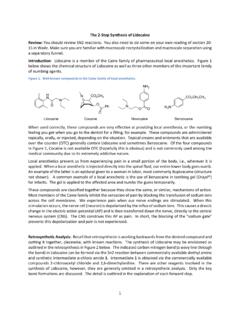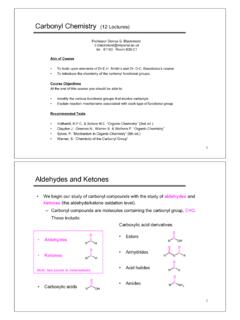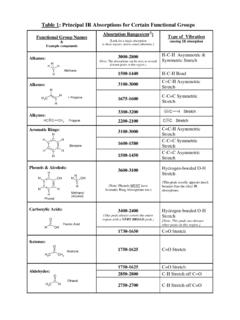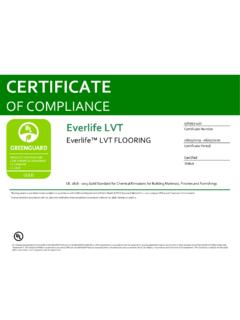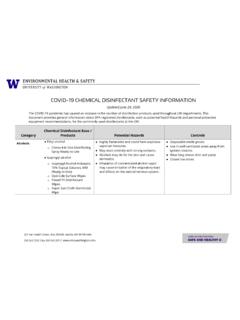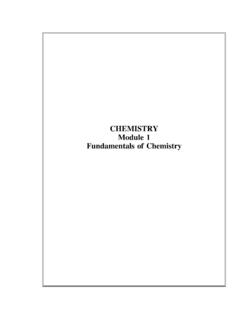Transcription of Identification of an Unknown – Alcohols, Aldehydes, and ...
1 Identification of an Unknown : Alcohols, aldehydes , and Ketones How does one determine the identity and structure of an Unknown compound? This is not a trivial task. Modern x-ray and spectroscopic techniques have made the job much easier, but for some very complex molecules, Identification and structure determination remains a challenge. In addition to spectroscopic information and information obtained from other instrumental methods, chemical reactions can provide useful structural information, and physical properties can contribute significantly to confirming the identity of a compound. In this experiment, you will be asked to identify an Unknown liquid, which will be either an alcohol, aldehyde, or ketone. Identification will be accomplished by carrying out chemical tests , called classification tests , preparing a solid derivative of the Unknown and determining its melting point (MP), making careful observations, and analyzing the NMR spectrum of the Unknown . the carbonyl group O O.
2 R OH R H R R. alcohol aldehyde ketone A list of alcohols, aldehydes , and ketones, along with the MP of a solid derivative of each compound, is posted on the website. The Unknown will be one of these listed compounds. If one can determine to which functional group class (alcohol, aldehyde, or ketone) the Unknown belongs, two of the three lists need not be considered and the task will be greatly simplified. To accomplish this, classification tests will be carried out. First, consider some general ways in which alcohols, aldehydes , and ketones react. 1. CLASSIFICATION tests , which are simple chemical reactions that produce color changes or form precipitates, can be used to differentiate alcohols, aldehydes , and ketones, and also to provide further structural information. Because color plays such an important role in this experiment, a separate handout on this topic is available on the course website. 2,4-Dinitrophenylhydrazine: aldehydes and ketones react with 2,4-dinitrophenylhydrazine reagent to form yellow, orange, or reddish-orange precipitates, whereas alcohols do not react.
3 Formation of a precipitate therefore indicates the presence of an aldehyde or ketone. The precipitate from this test also serves as a solid derivative. A discussion on derivatives will be given later in this handout. The mechanism of this reaction is that of imine formation and can be found in any organic lecture text. NO2 NO2. H H. O N a series of steps N. + H 2N R N. R. NO2 NO2. a ketone if .. R = carbon a 2,4-DNP hydrazone an aldehyde if .. R = H 2,4-DNP. (generally a solid). Ceric Ammonium Nitrate (CAN): Alcohols react with this yellow reagent to produce a color change (from yellow to red), but the carbonyl group is unreactive. This is a good experiment to test for the presence of an alcohol or to prove the absence thereof. Note that changing the groups attached to certain inorganic ions such as Ce4+ results in a change to the electronic structure, which results in a color change. Production of a magenta color, therefore, indicates the presence of an alcohol group. The 2 ammonium cations are present as spectators and do not participate.
4 2- + 2- O. R OH (NH4)2[Ce(NO3)6] R Ce(NO3)5. an alcohol CAN, a yellow solid an alkoxy cerium(IV) derivative Schiff's Reagent: Before looking at the reaction of Schiff's reagent, consider a much simpler system. The sulfur in the bisulfite ion acts as a nucleophile and adds to the carbonyl carbon. Because this is such a bulky nucleophile, it will add only to a relatively sterically unhindered carbonyl. This requires the carbonyl to be part of an aldehyde in which one of the R groups is the very small hydrogen, or a ketone having small R' groups. A ketone having large groups attached to the carbonyl will not react with bisulfite. OH O O R. +. S O S OH. O O R R. O R. aldehyde or sterically bisulfite addition bisulfite unhindered ketone complex aldehydes react with Schiff's reagent to produce a color change (magenta-colored addition product). In the same way, the Schiff reagent acts as a nucleophile that adds to the carbonyl group of an aldehyde. 2. Because this nucleophile is extremely bulky, a ketone, which is more sterically crowded than an aldehyde at the carbonyl carbon, does not react with Schiff's reagent, and thus does not produce the magenta color.
5 Production of the magenta color therefore indicates that the Unknown is an aldehyde and not a ketone. Note that generally, more extended systems of conjugation lead to colored compounds. Whereas the Schiff reagent itself has a limited system of conjugation, the adduct with an aldehyde has an extended system of conjugation, resulting in a highly colored compound. More can be found on color in the supplemental handout on the course website. SCHIFF TEST FOR aldehydes . NHSO2H (Very Hindered Nucleophile). R. O. H Aldehyde HO2 SNH2 SO3H (Ketone is too hindered - does not react). R. Schiff Reagent NHSO2 C OH. Limited Number of 3 molecules H. Resonance Forms of aldehyde NHSO2H R. COLORLESS HO C SO2NH. H. R. Schiff Adduct Highly Conjugated NHSO2 C OH. (13 resonance forms) H. MAGENTA COLOR. The results of these classification tests will allow the Unknown to be classified as an alcohol, an aldehyde, or a ketone. Additional structural information can be obtained from the iodoform test.
6 Iodoform Reaction: The iodoform test indicates the presence of an aldehyde or ketone in which one of the groups directly attached to the carbonyl carbon is a methyl group. Such a ketone is called a methyl ketone. In the iodoform test, the Unknown is allowed to react with a mixture of excess iodine and excess hydroxide. Hydrogens alpha to a carbonyl group are acidic and will react with the hydroxide to form the anion, which then reacts with iodine to form an alpha-iodo ketone. In a methyl ketone, all three alpha hydrogens are substituted by iodine in this way to form the triiodo compound, which then reacts with more hydroxide to form the carboxylate salt plus iodoform, a yellow precipitate. Formation of a yellow precipitate therefore indicates the presence of a methyl group directly attached to the carbonyl. O O O O O. Ph Ph Ph examples of methyl ketones ketones, but not methyl ketones 3. The mechanism of the iodoform reaction is that of alpha-halogenation of a carbonyl compound under basic conditions, followed by nucleophilic displacement of the resulting triiodomethyl group by hydroxide.
7 The mechanism is outlined below where all inorganic by-products are omitted for clarity. O O O. I2. H H I. + OH + I I. H H. H H H. O O O O. I I I I I + I OH. I HO I. I I I I H H. OH HO O O O. I I. I +. H +. I O I I O I I. I. iodoform, good leaving group a precipitate DERIVATIVE FORMATION: Simple chemical reactions that convert a liquid into a solid derivative provide another key piece of information. Why is it that the liquid Unknown changes to a solid derivative? The Unknown has a relatively low molecular weight (MW) and relatively low polarity, causing it to be a liquid at room temperature (RT). Derivatives are chosen to have a high MW and very high polarity, causing them to be solids at RT. The solid derivative is purified by recrystallization, and its MP. determined. The MP is then matched against the MPs of derivatives of the posted compounds. In this way the number of possibilities can be narrowed down to just a few compounds. 2,4-Dinitrophenylhydrazones: As shown above, both aldehydes and ketones react with 2,4- dinitrophenylhydrazine (DNP) to form a solid DNP derivative.
8 The classification test serves also as derivative formation. The color of this derivative can also provide useful structural information. If the solid is yellow, this most often means that the carbonyl group in the Unknown is non-conjugated. A. reddish-orange color most likely means that the carbonyl group is conjugated. There are exceptions to this, so care should be taken when interpreting this observation. In a few cases, compounds in which the carbonyl group is not conjugated produce orange precipitates. Note carefully that simply having a double bond or phenyl group somewhere in an aldehyde or ketone does not necessarily mean that the carbonyl group is conjugated. The double bond must be separated from the carbonyl by one single bond only. If the double bond is further away, it is isolated from the carbonyl and not conjugated with the carbonyl. 4. O. O. O O. conjugated carbonyls non-conjugated carbonyls 3,5-Dinitrophenylbenzoates (3,5-DNB): Alcohols react with 3,5-dinitrobenzoyl chloride to produce solid 3,5-DNB esters that follows the mechanism outlined below.
9 NO2. R'. O. Cl O. O +. R H Cl O R + Cl NO2 R H R' O. O H. 3,5-dinitrobenzoylchloride NO2. O R'. R. where R' = O. NO2 a 3,5-DNB Ester SUMMARY: The results of the classification tests enable one to limit the search to one of three lists of possible compounds. The results of these tests will provide information on whether the Unknown is an alcohol, aldehyde, or a ketone, and if it is an aldehyde or ketone, whether it is a methyl aldehyde or ketone, and possibly whether the carbonyl group is conjugated or not. Narrowing the possibilities further requires carefully obtaining the melting point of the purified solid derivative. Once this has been determined, the list of possible compounds, along with the MPs of the derivatives, can be consulted. For many unknowns, the MP of the derivative, together with the results of the classification tests will provide sufficient information to make a final conclusion as to the identity of the compound. Often, however, two or even three possibilities may have very similar test results and derivative MPs.
10 In such a case, the NMR spectrum can be used to make a final determination. A SAMPLE ANALYSIS: Unknown X produces a red/orange DNP, MP 159-161 and gives a neg Schiff and neg iodoform test. Pos DNP -> ald or ket. Red/orange DNP -> probably conjugated carbonyl. Neg Schiff -> not ald, therefore ketone. Neg iodoform -> not methyl ketone. Look up MP of derivative in table of ketones. Three compounds fall within likely range: cyclohexanone, isobutyrophenone, and 1- methoxy-2-propanone. O O. O. O. cyclohexanone, a non-conjugated isobutyrophenone, 1-methoxy-2-propanone, a conjugated carbonyl a methyl ketone carbonyl 5. The results point towards isobutyrophenone as being the Unknown . 1H-NMR would readily confirm this by indicating the presence of aromatic hydrogens and the common splitting pattern of an isopropyl group. Use the following flow diagram to help carry out the experiment. Unknown - recyst ppt 2,4-DNPH - dry no - mp ppt ppt aldehyde alcohol or ketone Ce+4. Schiff yellow no color to red change no color change magenta alcohol NOT alcohol ketone aldehyde 3,5-DNBC.

